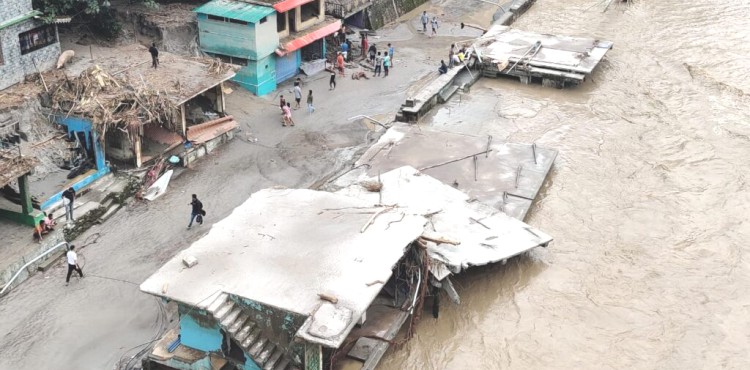




















Sunday, Jun 15, 2025 23:15 [IST]
Last Update: Saturday, Jun 14, 2025 17:46 [IST]
GANGTOK, : Increased sediment and silt deposition have seen Teesta River bed
increase by 6-7 metres in Teesta Bazaar area after the 2023 GLOF, with experts
expressing concerns that the settlement is more vulnerable to flooding.
Teesta
Bazaar is a vital route to connect Sikkim and Kalimpong with
Darjeeling-Kurseong region, and is located on the right bank of Teesta River
while NH 10 runs on the left bank. It falls under Kalimpong district.
According
to a Jal Shakti Ministry-appointed committee, deposits have forced Teesta River
to expand on both banks and the rightward channel shifting near settlements.
“At this
downstream location in West Bengal, the riverbed has risen by 6–7 meters
post-GLOF. The channel has also widened significantly towards the right bank.
This indicates that sediment from upstream found its deposition base here,
where the valley opens and gradient further reduces,” said the committee in its
report of April this year.
During the
2024 monsoon, the first monsoon after the GLOF, Teesta Bazaar had been flooded
with rising water levels of Teesta River which submerged some houses there.
Local residents, settled close to the river, took shelter in the houses of
their relatives or community halls. As the water level rose, the road from
Sikkim and Kalimpong via Lopchu-Peshok was also closed for a long period with
the road stretch at Teesta Bazaar submerged under water.
As per the
Jal Shakti Ministry’s committee, increased sediment and silt deposition have
caused a rise in the riverbed level, leading to concerns about potential
flooding and making the Teesta Bazaar area more vulnerable to future water
surges.
Besides
Teesta Bazaar, the Melli region is also vulnerable to flooding as the Teesta
River bed rose by nearly 14 m due to heavy siltation after the GLOF 2023.
The
Central committee was tasked to assess the morphological impacts caused by the
GLOF on Teesta River and to propose remedial measures. The committee members along
with officials from Sikkim and West Bengal governments conducted site visit
from July 15, 2024, to July 19, 2024 covering the problem areas in Sikkim and
West Bengal.
In its
report, the committee recorded that the GLOF incident triggered significant
geomorphological changes along the Teesta River in Sikkim and parts of West
Bengal. The study is crucial as NH 10 – the lifeline of Sikkim – runs alongside
the Teesta River.
Key
findings highlight differential river behavior, erosion dominating the upper
steep reaches and heavy sedimentation in the lower flatter segments. Satellite
imagery and cross-sectional analysis confirmed major sediment deposition,
lateral shifting, and changes in channel morphology.
These
impacts are most pronounced in Mangan, Dikchu, Singtam, Rangpo, Melli, and
Teesta Bazar stretches of Teesta River.
The study
recommended a cautious and phased approach to river management: allowing
natural stabilization in less critical zones while prioritizing targeted river
training works, catchment treatment, and floodplain zoning in vulnerable areas.
